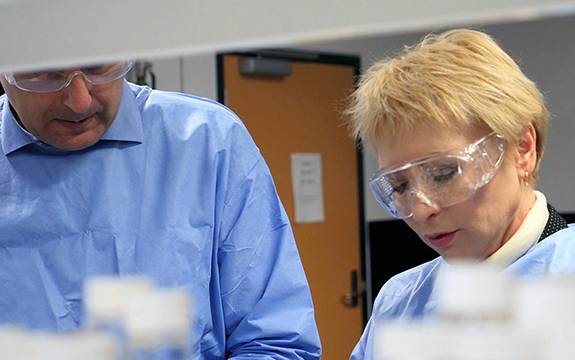Bacteria busters capture Eureka Prize for Swinburne

In Summary
- Professors Elena Ivanova and Saulius Juodkazis win 2017 UNSW Eureka Prize for Scientific Research
- Mimicking the surfaces of dragonfly and cicada wings they developed a new form of self-sterilising material
Swinburne researchers, Professor Elena Ivanova and Professor Saulius Juodkazis, have won the prestigious 2017 UNSW Eureka Prize for Scientific Research.
Their research could offer scientists worldwide a new weapon in the fight against the growing epidemic of antibiotic resistant bacteria.
Accepting the award at a gala dinner at the Sydney Town Hall, Professor Ivanova acknowledged the work and support of her team of collaborators and students who contributed to this project.
“It is very exciting to see recognition of our work,” she said.
After observing bacteria being killed on the wings of cicadas and dragonflies, the researchers replicated the surface patterns on a nano-material constructed out of metallic materials with tiny self-sterilising protrusions.
They found that these nanopillars – tiny spikes about one thousandth of the thickness of a human hair – killed bacteria it came into contact with.
In particular they were studying the bacteria, Pseudomonas aeruginosa, which the World Health Organisation has named second on its global list of antibiotic resistant pathogens urgently requiring a new form of treatment.
According to Professor Ivanova, it is possible to construct biomedical implants covered in these nano-pillars that could attract and kill the bacteria present in a patient.
“Because this is a mechanical process it’s less likely that the bacteria will be able to develop resistance to this material,” she said.
The discovery has resulted in a partnership with Global Orthopaedic Technology, an Australian-owned implant designer and manufacturer.
Commercial development of these antibacterial surfaces would potentially allow an antimicrobial nano-surface to be engineered onto existing medical devices.
The team hopes to produce titanium hip replacements coated in the microscopic arrays, and consequently resistant to infection — a problem affecting some of the millions of people who receive artificial joints.
They also plan to fabricate the nanostructures on non-metallic surfaces such as plastic, ceramics, glass and silicon. Applications could range from pathogen-proof paint that could be used on hospital walls and floors to infection-resistant water filtration systems.
Read more about Professor Ivanova’s research.
Read more about Professor Juodkazis’s research.
Eureka Prizes
Known as the Oscars of Australian Science, the Eureka Awards are presented annually by the Australian Museum. They reward excellence in the fields of scientific research and innovation, science leadership, school science and science journalism and communication.

